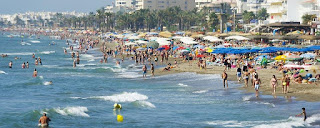 |
| Costadelsol continues to break ts own records |
It’s been shown by recent news events that the 17 autonomous regions of Spain are proud of their heritage and identity and rightly so, including their cuisine, language, culture, and history.
Despite all this, one of the most famous spots in all of
Spain isn’t one of the autonomous regions. It’s the “Costa del Sol”, which is
loosely defined as a slice of the eastern coastline of southern Spain. Most of
the area comes under the jurisdiction of the province of Malaga, but if you
asked someone in a region like Manilva if they consider themselves to be in
Malaga and they would say no.
The entirety of the Costa del Sol does fall within the
autonomous region of Andalucía, which does give the region some uniformity when
it comes to their terrain, climate, and cuisine.
The unique strengths of the Costa del Sol are most apparent
when you break it down even further and go to the regional level. Here are
three reminders of what makes the Costa del Sol so special…
It’s Truly International
The Costa del Sol is home to the Malaga airport, which makes
it easy for people all over the world to make their way to the region. This
makes the area more international than anywhere else in Andalucía and puts it
on a level even higher than that of Seville. The Costa del Sol is perhaps the
most international region in all of Spain with the exception of Barcelona,
Ibiza, and Madrid.
This means that the region is home to the finest bars,
restaurants, fashions, and trends. Marbella is still the home of the
international jet set; Fuengirola is still at the forefront of mass tourism,
and Puerto Banus is still the destination of celebrities, movie stars,
footballers, and multi-millionaires alike.
There’s More Variety Than you Think
For all the he hotel complexes with pools, restaurants, and
family entertainment options hugging the Costa del Sol coastline, there’s
plenty of charming villages that provide visitors with a real taste for
traditional Spanish life.
For all the expat enclaves complete with pubs, plumbers,
football teams, electricians, cafes, and schools built for Brits, there are
similar places that have a Scandinavian feel to them, not to mention the places
with German flavours and the growing influence of Asia. Even so, the Costa del Sol as a whole remains strictly Spanish. There are cobbled streets with
Andalusians that have been there for generations even in Marbella. It’s this
variety that makes the area so fascinating.
It’s Beautiful
Not much can prepare someone for the sights and sounds that
will be waiting them on a Friday night on a Friday night in summer along the
Puerto Banus second line. Stag and hen parties alike filling the air, stylish
Swedes walking the streets, a mixture of American, British, Irish, German, and
Spanish people mingling and enjoying themselves. The Costa del Sol is a place
where anyone can come together and party the night away for a few weeks out of
the year, which is what it is most known for.
There’s still so much more to the region though. Don’t
forget the beaches which come in rural and packed. The resorts which can be as
cheap or expensive as you need them to be. A wide choice of properties matching
every taste and budget waiting for a buyer. Then there is the terrain, which
can go from an urbanised beach to the wilderness of the mountains in a matter
of miles.
The Costa del Sol really does offer something for everyone.


